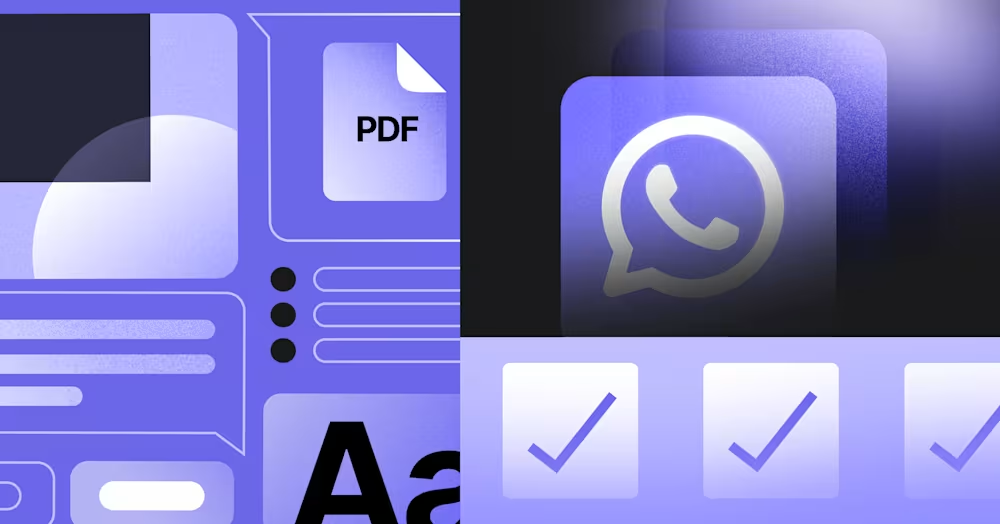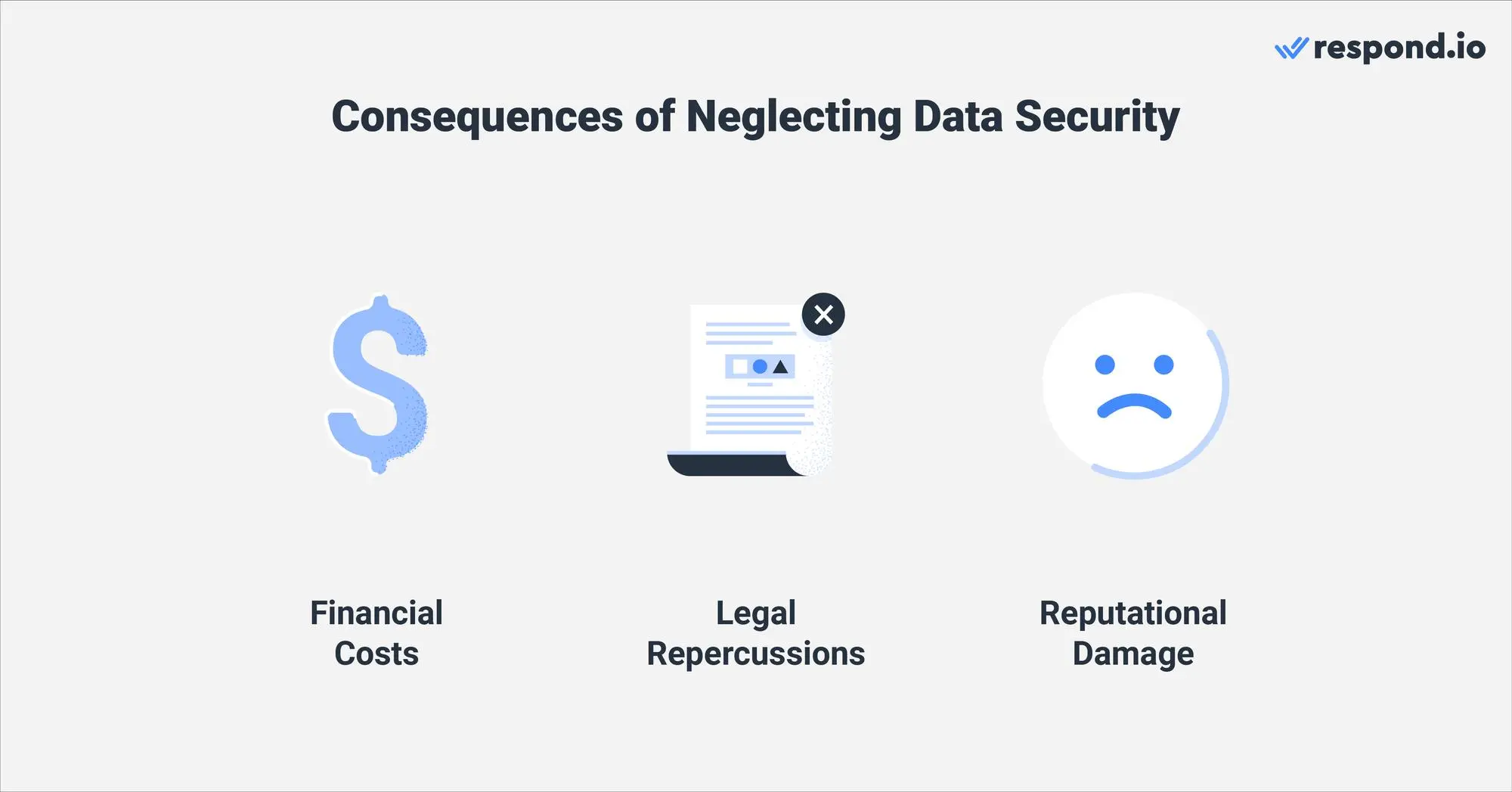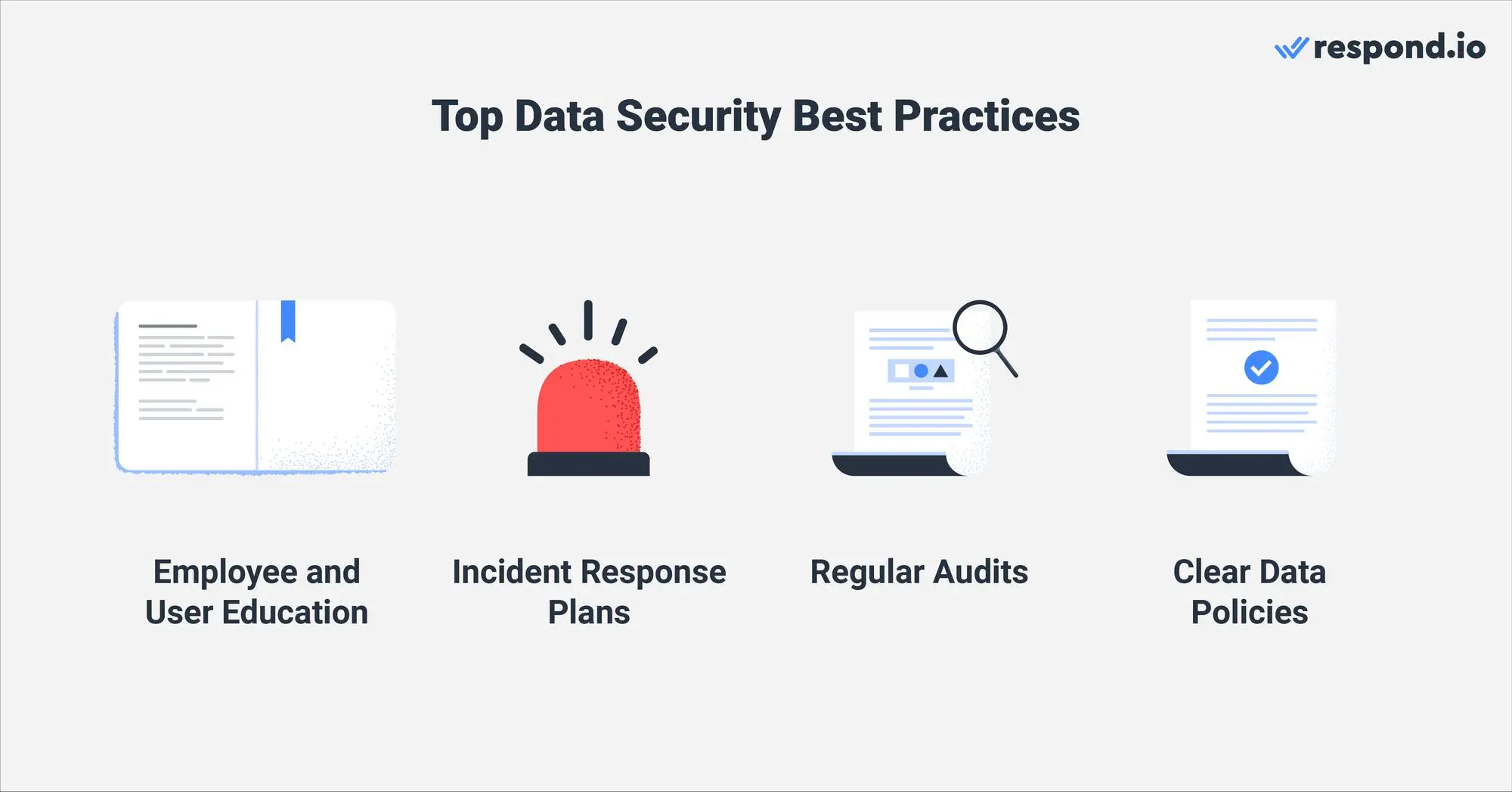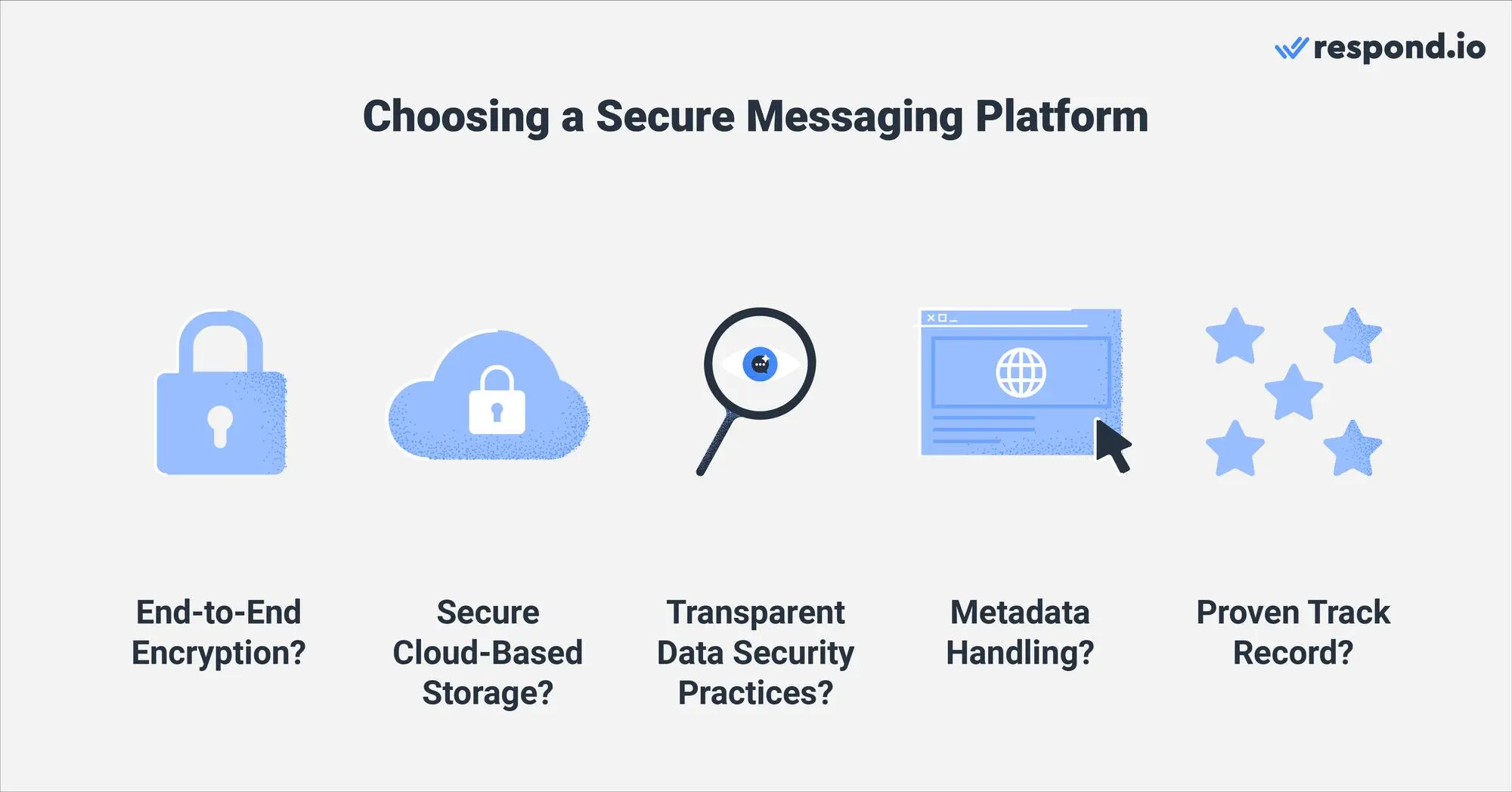
WhatsApp 訊息範本:包含 13 個範例的操作指南
除非使用 WhatsApp 訊息模板,否則企業無法在 24 小時後發送 WhatsApp 訊息。 了解如何格式化和傳送範本訊息以及範例。
![安全訊息傳遞:您需要了解的一切 [2024 年 4 月]](https://assets2-proxy.respond.io/ph8r57dk1q9w/4cpmOKD8KfWzmGyq2hula1/ce2c4d5b2e3786f5ddc322a8662a318b/articles-respond-security-features-cover-1_031618d0bd39d0696ab6299571a8fb2e.png?q=70&fm=avif)
在現今的安全資訊傳遞環境中,資料外洩十分常見。 由 Telegram 和 Facebook Messenger 到 Slack,沒有一家企業能夠免受事故影響。 即使在2023年,我們已經看到了驚人的80億數據洩漏和網絡攻擊。
但這些統計數據實際上不只是數字——它是一個警鐘,提醒像您這樣的企業要認真對待資料安全和安全訊息傳遞。
雖然不可能保證完全防止違規行為,但您可以採取主動的安全方法來最大限度地降低風險,以更好地保護您的組織,更重要的是,保護您的客戶。
從本質上講,資料安全就是保護您的 數位資訊。
就像將您的貴重物品安全地存放在銀行一樣,資料安全性透過各種方法(例如存取控制、加密、 雙重認證 和安全性稽核)保護您的資料免受惡意(例如網路釣魚)和非惡意(例如人為錯誤)事件的侵害。
您的組織對資料安全所需採取的謹慎程度在不同的行業中會有很大差異。 例如,考慮處理敏感個人資料的金融機構或醫院。 與透過 Facebook Marketplace 銷售二手電子產品的家族企業相比,由於需要遵守 HIPAA 和 GDPR 等特定法規,安全漏洞的潛在後果對他們來說要高得多。
也就是說,無論您的規模或行業如何,資料安全都必須放在首位,因為整個企業的信譽都取決於它。
確保資料安全是不容商榷的。 2023 年全球資料外洩平均成本為 445 萬美元。 此外,麥肯錫的一項研究發現,87%的客戶表示,如果對公司的安全做法有疑慮,他們將不會與之做生意。

這兩個統計數據意味著一件事:風險很高,不容犯錯。 安全不只是一種可有可無的東西;這是必要的,因為如果做錯了,後果包括:
洩漏可不是便宜的事,相關的財務成本甚至會讓大型企業也感到疼痛。 除了法律和監管處罰之外,還需要投入大量資源用於事件回應、補償客戶、危機管理和開發更先進的安全基礎設施。
更糟的是,如果您的公司是上市公司,違規行為幾乎總是會影響您的股價,從而降低您的市值。
企業有法律義務採取明確措施保護其客戶' 數據,並且無論違規是故意還是意外,他們都將承擔全部處罰。
儘管處罰因具體司法管轄區和行業的不同而有很大差異,但企業可能會面臨罰款、監管制裁、公開通知要求,甚至來自客戶的個人訴訟。
任何組織的命脈都在於其客戶,因為沒有客戶,就沒有人可以銷售產品和服務。 違反安全也會違反客戶' 的信任。 沒有人希望自己的個人資料(無論是地址還是信用卡詳細資料)落入壞人之手。
顧客們也議論紛紛。 因此,除了他們可能會把生意轉向其他地方外,也不要驚訝於他們開始與朋友和家人分享他們的經歷,以及通過負面的在線評論和社交媒體帖子發聲。
人們每天會發送 230 億封即時訊息 以及 3616 億封電子郵件,這應該會讓您深刻認識到確保商業訊息安全是一項艱鉅的任務。 這可能會讓人感到畏懼,因為您的組織和解決方案的好壞取決於支持它們的安全性,因此建議一步一步來。

雖然無法確保發送和接收的所有訊息都是萬無一失的,但只要您遵循這些關鍵做法,就能顯著簡化您的安全流程:
人類因素在洩漏中經常是最弱的環節,員工和客戶都同樣脆弱。 為了緩解這種情況,請考慮就最佳資料安全和安全訊息傳遞實踐實施全面、頻繁的培訓課程。
這些會議可能包括有關安全政策、網路釣魚意識甚至預防措施的研討會。 結合使用網路研討會、電子報和互動式電子學習平台也有助於確保您的內容能夠被盡可能多的受眾所存取和吸引。
一旦發生安全漏洞,就必須分秒必爭,控制損失,防止事態惡化。
事件回應計畫 在這裡非常重要,因為它們提供了清晰的路線圖,概述了需要採取哪些行動以及在發生違規行為時應該聯繫哪些利害關係人。 從事件識別到恢復,再到解決公關問題,這些計劃使原本混亂的事件變得有條不紊。
企業必須始終努力實現兩個目標:不斷改進安全實踐並盡量減少自滿。 實現此目標的一種可靠方法是透過內部安全審計,這有助於讓團隊保持警惕。
安全審計會評估您已建立的安全標準是否已維護,並找出在被利用之前需要解決的任何潛在漏洞和漏洞,最終幫助您避免未來的巨額成本。
擁有清晰、定義明確的資料安全策略不僅概述了您如何遵守法律法規、處理資料使用和收集以及定義誰有存取權限。 它向客戶表明您完全致力於保護他們的數據並對此保持透明,最終加強您作為負責任組織的聲譽。
也就是說,政策只有在實際被閱讀時才會有效。 記住你的受眾:他們不一定都是律師,因此避免使用技術術語,確保你的政策用簡單的語言撰寫。
您可以完全遵循上述最佳做法,但如果您使用的平臺本質上存在漏洞,那麼這一切都將是徒勞無功的。 您選擇用來與客戶互動的平台與您實施的實務同樣重要。

為了幫助您選擇最安全的訊息平台,請就您的選擇詢問以下問題:
端對端加密是必不可少的,它可以保護您的資料不僅免受惡意實體的侵害,還可以保護您的資料免受政府甚至大公司的侵害。 這種加密確保訊息從發送那一刻起直到成功送達預期收件人為止都是完全安全的,這項功能對於通訊尤其重要。
在雲端儲存資料既方便又普遍,雖然它可以提供相當程度的資料保護,但請注意,安全等級完全取決於提供者。 例如,Microsoft Azure、Google Cloud Platform (GCP) 和 Amazon Web Services (AWS) 被認為是最有信譽和最安全的供應商。
真正安全的訊息傳遞平台應該對其安全實踐保持透明。 這意味著不僅僅是陳述他們的程序;他們還應該公開討論如何處理違規行為、他們使用的安全協議以及未來增強安全性的計劃。
元數據,包括位置、姓名、電話號碼、網路歷史記錄等,拼湊在一起時可以揭示大量令人震驚的資訊。 確切了解您的平台存儲多少以及存儲哪種類型的數據是至關重要的。 在選擇安全的 CRM 或平台之前,請考慮您對收集的資料的滿意度。
一個好的消息傳遞平台不僅僅具有頁面上宣傳的功能。 它應該有經過實際客戶測試、積極使用和認可的歷史。 在研究潛在平台時,請務必造訪 G2 和 Capterra 等評論網站,以了解其安全性和可靠性。
Respond.io 始終將 安全 放在首位,採取細緻、積極主動的方式,不斷確保採取的一切都滿足現在和將來安全即時通訊的需求。
現在讓我們仔細看看過去一年實施的一些關鍵安全措施:
ISO 27001:2022認證由國際標準化組織(ISO)頒發,是一項全球公認的標準,專注於建立、維護和持續改善系統的資料安全風險管理系統。
要獲得 ISO 27001:2022 認證絕非易事。 它強調了一種保護敏感資訊的複雜而係統性的方法。

2023 年 8 月,response.io 取得了一個重要的里程碑, 獲得了 ISO 27001:2022 認證,鞏固了其堅定不移地致力於保護客戶資料免受各種威脅的承諾。
對於目前的 respond.io 使用者來說,此項認證不僅僅意味著安心。 這意味著人們對平台'的能力有更大的信心,可以使用最嚴格的安全協議和風險管理框架來保護敏感數據,從而大大降低未經授權的數據存取和資料外洩的可能性。
為了改善現有的安全措施並增強使用者體驗,response.io 引入了安全斷言標記語言 (SAML) 單一登入 (SSO) 功能。
透過要求使用一組憑證,這極大地簡化了單一組織內不同線上服務和部門之間的登入體驗。 除了方便之外,SSO 還消除了對多個密碼的依賴,從而降低了與密碼相關的洩漏風險,並為所有用戶提供了更無縫、更安全的體驗。
在其強大的安全措施清單中,respond.io 加入了 雙重認證 (2FA),透過解決僅有密碼保護的漏洞進一步加強了安全性。
2FA 背後的想法簡單而有效。 它要求使用者在輸入密碼時,輸入其行動裝置上的外部身份驗證器應用程式提供的代碼。 雖然這聽起來很麻煩,但當密碼落入壞人之手時,它可以提供另一層防禦。
本質上,這個兩步驟驗證過程降低了未經授權存取的可能性,增強了使用者對其資料安全的信心。
隱藏您的電話號碼和電子郵件地址是抵禦潛在威脅的有效方法,包括網路釣魚攻擊、社會工程攻擊和普通的垃圾郵件。
這被稱為屏蔽,是 respond.io 最近推出的一項功能。
但除了一般使用者之外,屏蔽對於管理個人敏感資料的人來說尤其有價值。 在當今的數位世界中,資料外洩越來越常見,能夠隱藏聯絡資料不僅是一種便利,而是一種必需,使未經授權的實體更難利用你的使用者。
您是否正在尋找一款領先的客戶對話管理軟體,其安全性與其功能同樣重要? 註冊一個 免費的 respond.io 帳戶,以體驗我們的先進安全措施如何與我們的功能套件無縫整合。
如果您發現我們對資料安全的見解很有趣,我們邀請您查看以下內容:
Ryan Tan 是倫敦政經學院 (LSE) 法學畢業生,也是 respond.io 的高級內容撰稿人。 憑藉他的 B2B 技術行銷和四大經驗,他致力於創作既能教育又能娛樂精通技術的受眾的內容。 Ryan 擅長揭開商業訊息的神秘面紗,為讀者提供實用的見解,為強勁成長鋪平道路。